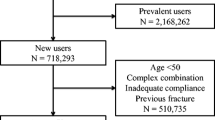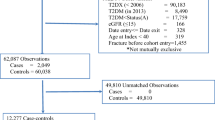Abstract
Introduction
We aimed to clarify the risks of initiating antidiabetic drugs for fractures using a nationwide health insurance claims database (NDBJ).
Materials and Methods
Patients aged ≥ 65 years initiating antidiabetic drugs at the outpatient department were enrolled after a 180-day period without prescribed antidiabetic drugs and followed with during 2012–2018 using NDBJ. The adjusted hazard risks (HRs) of each antidiabetic drug (thiazolidine, alpha-glucosidase inhibitor, dipeptidyl peptidase-4 [DPP-4] inhibitor, sulfonylurea, glinide, and insulin) for fractures compared with biguanide were obtained adjusting for age, gender, polypharmacy, dementia, and the other antidiabetic drugs.
Results
The DPP-4 inhibitor was the most often prescribed antidiabetic drug followed by biguanide with prescribed proportions of 71.7% and 12.9%. A total of 4,304 hip fractures and 9,388 vertebral fractures were identified among the 966,700 outpatient participants. Compared with biguanide, insulin, alpha-glucosidase inhibitor, and DPP-4 inhibitor were related to increased hip fracture risks. Vertebral fracture risk was higher in outpatients prescribed with insulin, thiazolidine, and DPP-4 inhibitor compared with biguanide. Patients prescribed insulin for hip and vertebral fractures’ adjusted HRs were 2.17 (95% CI 1.77–2.66) and 1.45 (95% CI 1.24–1.70), respectively. Those prescribed DPP-4 inhibitor for hip and vertebral fractures’ adjusted HRs were 1.27 (95% CI 1.15–1.40) and 1.20 (95% CI 1.12–1.28), respectively.
Conclusions
Initiating insulin increased the risk of not only hip fractures but also vertebral fractures. Patients initiating antidiabetic drugs had increased risks of hip and vertebral fractures compared with those initiating biguanide independently for age, gender, polypharmacy, and dementia in the Japanese elderly.

Similar content being viewed by others
References
International Diabetes Federation. IDF Diabetes Atlas 10th edition 2021. https://diabetesatlas.org/idfawp/resourcefiles/2021/07/IDF_Atlas_10th_Edition_2021.pdf P35~41. Accessed on 22nd February, 2022
Basu R, Breda E, Oberg AL et al (2003) Mechanisms of the age-associated deterioration in glucose tolerance: Contribution of alterations in insulin secretion, action, and clearance. Diabetes 52:1738–1748
National Institutes of Biomedical Innovation, Health and Nutrition (2021) The National Health and Nutrition Survey Japan, 2019. P159–160. Daiichi Syuppan. 2021, Tokyo
Amiel SA, Dixon T, Mann R et al (2008) Hypoglycemia in type 2 diabetes. Diabet Med 25:245–254
Huang ES, Laiteerapong N, Liu JY et al (2014) Rates of complications and mortality in older patients with diabetes mellitus: the diabetes and aging study. JAMA Intern Med 174:251–258
Johnston SS, Conner C, Aagren M et al (2012) Association between hypoglycemic events and fall-related fractures in Medicare-covered patients with type 2 diabetes. Diabetes Obes Metab 14:634–643
Lee AK, Juraschek SP, Windham BG et al (2020) Severe hypoglycemia and risk of falls in type 2 diabetes: The Atherosclerosis Risk in Communities (ARIC) study. Diabetes Care 43:2060–2065
Hung YC, Lin CC, Chen HJ et al (2017) Severe hypoglycemia and hip fracture in patients with type 2 diabetes: a nationwide population-based cohort study. Osteoporos Int 28:2053–2060
Flory J, Lipska K (2019) Metformin in 2019. JAMA 321:1926–1927
Buse JB, Wexler DJ, Tsapas A et al (2020) 2019 Update to: Management of hyperglycemia in type 2 diabetes, 2018. A consensus report by the American Diabetes Association (ADA) and the European Association for the Study of Diabetes (EASD). Diabetes Care 43:487–493
American Diabetes Association (2021) 9. Pharmacologic approaches to glycemic treatment: standards of medical care in diabetes-2021. Diabetes Care 2 (Suppl 1):S111-S124
Hidayat K, Du X, Wu MJ et al (2019) The use of metformin, insulin, sulfonylureas, and thiazolidinediones and the risk of fracture: Systematic review and meta-analysis of observational studies. Obes Rev 20:1494–1503
Salari-Moghaddam A, Sadeghi O, Keshteli AH et al (2019) Metformin use and risk of fracture: a systematic review and meta-analysis of observational studies. Osteoporos Int 30:1167–1173
Fukushima M, Suzuki H, Seino Y (2004) Insulin secretion capacity in the development from normal glucose tolerance to type 2 diabetes. Diabetes Res Clin Pract 66:S37-43
The Japan Diabetes Society, the Japan Geriatrics Society (2017) Practice Guideline for the Treatment of Elderly Diabetes in Japan. P61–64. Nankodo, Tokyo
The Japan Diabetes Society (2019) Practice Guideline for the Treatment of Diabetes in Japan. P70. Nankodo, Tokyo
Matsuda S, Fujimori K (2012) The claim database in Japan. APJDM (Asian Pacific journal of disease management. 3: 55–59
Fujimori K (2012) Practical use of E-claim data for regional healthcare planning. Nihon Eiseigaku Zasshi 67:56–61(in Japanese)
Japanese Ministry of Health, Labour and Welfare, Proportion of electronic claims in the Japanese health insurance system, 2016. https://www.mhlw.go.jp/file/06-Seisakujouhou-12400000-Hokenkyoku/0000099002.pdf. Accessed on 14th May, 2022
Nakatoh S, Fujimori K, Ishii S et al (2021) Insufficient increase in bone mineral density testing rates and pharmacotherapy after hip and vertebral fracture: analysis of the National Database of Health Insurance Claims and Specific Health Checkups of Japan. Arch Osteoporos 16:130. https://doi.org/10.1007/s11657-021-00992-9 (PMID: 34510296)
Iki M, Fujimori K, Nakatoh S, et al (2022) Guideline adherence by physicians for management of glucocorticoid-induced osteoporosis in Japan: a nationwide health insurance claims database study. Osteoporos Int doi: https://doi.org/10.1007/s00198-021-06265-y. Online ahead of print. PMID: 35022812
Japanese Ministry of Health Labour and Welfare. (2020 Guideline for secondary use of the National Database of Health Insurance Claims and Specific Health Check-ups of Japan. October, 2020 (Amended in March, 2022). P33
https://www.mhlw.go.jp/content/12400000/000904655.pdf. Accessed on 11th March, 2022
Morita Y, Murayama H, Odawara M et al (2019) (2019) Treatment patterns of drug-naive patients with type 2 diabetes mellitus: a retrospective cohort study using a Japanese hospital database. Diabetol Metab Syndr 11:90. https://doi.org/10.1186/s13098-019-0486-y.eCollection (PMID: 31695754)
Al-Mashhadi Z, Viggers R, Fuglsang-Nielsen R et al (2020) Glucose-lowering drugs and fracture risk-a systematic review. Curr Osteoporos Rep 18:737–758
Hippisley-Cox J, Coupland C (2012) Derivation and validation of updated QFracture algorithm to predict risk of osteoporotic fracture in primary care in the United Kingdom: prospective open cohort study. BMJ 22:e3427. https://doi.org/10.1136/bmj.e3427
Zhang YS, Zheng YD, Yuan Y et al (2021) Effects of anti-diabetic drugs on fracture risk: a systematic review and network meta-analysis. Front Endocrinol (Lausanne) 12:2021. https://doi.org/10.3389/fendo.2021.735824.eCollection (PMID: 34721294)
Kalaitzoglou E, Fowlkes JL, Popescu I et al (2019) Diabetes pharmacotherapy and effects on the musculoskeletal system. Diabetes Metab Res Rev 35:e3100. https://doi.org/10.1002/dmrr.3100
American Diabetes Association (2018) 8. Pharmacologic Approaches to Glycemic Treatment: Standards of Medical Care in Diabetes-2018. Diabetes Care 41:S73–S85
Kidney Disease: Improving Global Outcomes (KDIGO) Diabetes Work Group (2020) KDIGO 2020 Clinical Practice Guideline for Diabetes Management in Chronic Kidney Disease. Kidney Int 98:S1–S115
Kadowaki T, Sarai N, Hirakawa T et al (2018) Persistence of oral antidiabetic treatment for type 2 diabetes characterized by drug class, patient characteristics and severity of renal impairment: A Japanese database analysis. Diabetes Obes Metab 20:2830–2839
Zhang Y, Chen Q, Liang Y et al (2019) Insulin use and fracture risk in patients with type 2 diabetes: A meta-analysis of 138,690 patients. Exp Ther Med 17:3957–3964
Kanazawa I, Yamaguchi T, Yamamoto M et al (2010) Relationship between treatments with insulin and oral hypoglycemic agents versus the presence of vertebral fractures in type 2 diabetes mellitus. J Bone Miner Metab 28:554–560
Kim JH, Choi HJ, Ku EJ et al (2015) Trabecular bone score as an indicator for skeletal deterioration in diabetes. J Clin Endocrinol Metab 100:475–482
Koromani F, Oei L, Shevroja E et al (2020) Vertebral fractures in individuals with type 2 diabetes: More than skeletal complications alone. Diabetes Care 43:137–144
Zhang Z, Cao Y, Tao Y et al (2020) Sulfonylurea and fracture risk in patients with type 2 diabetes mellitus: A meta-analysis. Diabetes Res Clin Pract 159:107990
Tao Y, Meng E, Shi J et al (2021) Sulfonylureas use and fractures risk in elderly patients with type 2 diabetes mellitus: a meta-analysis study. Aging Clin Exp Res 33:2133–2139
Zhu ZN, Jiang YF, Ding T (2014) Risk of fracture with thiazolidinediones: an updated meta-analysis of randomized clinical trials. Bone 68:115–123
Vilaca T, Schini M, Harnan S et al (2020) The risk of hip and non-vertebral fractures in type 1 and type 2 diabetes: A systematic review and meta-analysis update. Bone 137:115457. https://doi.org/10.1016/j.bone.2020.115457 (Epub 2020 May 29PMID: 32480023)
Ministry of Health, Labour and Welfare. Patient Survey 2017. https://www.mhlw.go.jp/toukei/saikin/hw/kanja/17/index.html. Accessed on 1st March, 2022
Cooper C, Atkinson EJ, O’Fallon WM et al (1992) Incidence of clinically diagnosed vertebral fractures: a population-based study in Rochester, Minnesota, 1985–1989. J Bone Miner Res 7:221–227
Kanazawa I, Notsu M, Takeno A et al (2019) Overweight and underweight are risk factors for vertebral fractures in patients with type 2 diabetes mellitus. J Bone Miner Metab 37:703–710
Acknowledgements
The authors thank the personnel of the Osteoporosis Foundation to support the present study. Sources of funding for the present article were as follows: a 52nd Taiju Life Social Welfare Foundation Medical Research Grant 2019, a Japan Osteoporosis Foundation Grant for Bone Research 2019, and a 28th Pfizer Health Research Grant 2019. The funding bodies had no role in either designing the study, collecting and analyzing the, or interpreting the findings, writing the manuscript, or choosing the journal to submit the manuscript.
Funding
Taiju Life Social Welfare Foundation,a 52nd Taiju Life Social Welfare Foundation Medical Research Grant 2019,Junko Tamaki,Japan Osteoporosis Foundation,a Japan Osteoporosis Foundation Grant for Bone Research 2019,Junko Tamaki,Pfizer Japan,a 28th Pfizer Health Research Grant 2019,Junko Tamaki
Author information
Authors and Affiliations
Contributions
JT got funding, designed a research question, analyzed the data, and made the original draft of the manuscript. SO conceptualized the study, and reviewed the manuscript. KF conceptualized and supervised the study, made the dataset, and reviewed the manuscript. SI administered the study project, and reviewed the manuscript. SN and NO conceptualized the study and reviewed the manuscript. KK reviewed the manuscript. MI planned the study project, conceptualized and supervised the study, and reviewed the manuscript.
Corresponding author
Ethics declarations
Conflict of interest
Shigeyuki Ishii has received written manuscripts fees for Asahi Kasei Pharma Ltd. and honorarium from Teijin Pharma Ltd.. Shinichi Nakatoh has received payments for lectures, speakers’ bureau fees from Asahi-Kasei Pharmaceutical Co. Ltd., Amgen K. K. and Astellas Pharma Inc.. Nobukazu Okimoto has received honoraria for lectures from Asahi-Kasei Pharmaceutical Co. Ltd., Amgen Astellas Biopharma K.K., Astellas Pharma Inc., Chugai Pharmaceutical Co., Daiichi-Sankyo Co. Ltd., Eisai Co. Ltd., Eli Lilly Japan, and Teijin Pharma Ltd.. Junko Tamaki, Sumito Ogawa, Kenji Fujimori, Kuniyasu Kamiya and Masayuki Iki declare that they have no conflicts of interest.
Additional information
Publisher's Note
Springer Nature remains neutral with regard to jurisdictional claims in published maps and institutional affiliations.
Supplementary Information
Below is the link to the electronic supplementary material.
About this article
Cite this article
Tamaki, J., Ogawa, S., Fujimori, K. et al. Hip and vertebral fracture risk after initiating antidiabetic drugs in Japanese elderly: a nationwide study. J Bone Miner Metab 41, 29–40 (2023). https://doi.org/10.1007/s00774-022-01372-0
Received:
Accepted:
Published:
Issue Date:
DOI: https://doi.org/10.1007/s00774-022-01372-0




